Cliff


In geography and geology, a cliff is a significant vertical, or near vertical, rock exposure. Cliffs are formed as erosion landforms due to the processes of erosion and weathering that produce them. Cliffs are common on coasts, in mountainous areas, escarpments and along rivers. Cliffs are usually formed by rock that is resistant to erosion and weathering. Sedimentary rocks are most likely to form sandstone, limestone, chalk, and dolomite. Igneous rocks, such as granite and basalt also often form cliffs.
An escarpment (or scarp) is a type of cliff, formed by the movement of a geologic fault, or a landslide.
Most cliffs have some form of scree slope at their base. In arid areas or under high cliffs, these are generally exposed jumbles of fallen rock. In areas of higher moisture, a soil slope may obscure the talus. Many cliffs also feature tributary waterfalls or rock shelters. Sometimes a cliff peters out at the end of a ridge, with tea tables or other types of rock columns remaining.
The Ordnance Survey distinguishes between cliffs (continuous line along the top edge with projections down the face) and outcrops (continuous lines along lower edge).

Large and famous cliffs
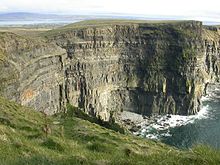
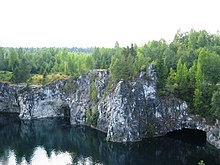
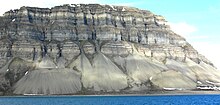
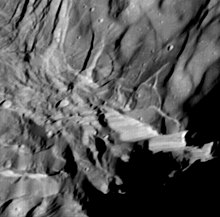
Given that a cliff need not be exactly vertical, there can be ambiguity about whether a given slope is a cliff or not, and also about how much of a certain slope to count as a cliff. For example, given a truly vertical rock wall above a very steep slope, one could count only the rock wall, or the combination. This makes listings of cliffs an inherently uncertain endeavor.
Some of the largest cliffs on Earth are found underwater. For example, an 8000 metres drop over an only 4250 metre span can be found at a ridge sitting inside the Kermadec Trench.
The highest cliff (rock wall, mountain face) in the world, is Nanga Parbat's Rupal Flank in the Himalayas, that rises 4600 metres above its base. According to other sources, the highest cliff in the world, about 1,340 m high, is the east face of Great Trango in the Karakoram mountains of northern Pakistan. This uses a fairly stringent notion of cliff, as the 1,340 m figure refers to a nearly vertical headwall; adding in a very steep approach brings the total height to over 1,600 m.
The location of the world's highest sea cliffs depends also on the definition of 'cliff' that is used. The Guinness record books claim it is Kalaupapa, Hawaii[2], at 1,010 m high. Another contender is the north face of Mitre Peak, which drops 1683 metres to Milford Sound, New Zealand [3]. These are subject to a less stringent definition, as the average slope of these cliffs at Kaulapapa is about 1.7, corresponding to an angle of 60 degrees, and Mitre Peak is similar. A more vertical drop into the sea can be found at Maujit Qaqarssuasia (also known as the 'Thumbnail') which is situated in the Torssakutak fjord area at the very tip of South Greenland and drops 1560m near-vertically[4][5].
Considering a truly vertical drop, Mount Thor on Baffin Island in Arctic Canada is often considered the highest at 1,370 m (4,500 ft) high in total (the top 480 m (1,600 ft) is overhanging), and is said to give it the longest purely vertical drop on Earth at 1,250 m (4,100 ft). There is some doubt as to whether this height is exceeded by other cliffs on Baffin Island or in Greenland, however.
The highest cliff in the solar system may be Verona Rupes, an approximately 20 km (12 mile) high fault scarp on Miranda, a moon of Uranus.
The following is an incomplete list of cliffs of the world.
Asia
Above Land
- Nanga Parbat, Azad Kashmir, Pakistan, 4600 m
- Trango Towers: East Face Great Trango Tower, Baltoro Muztagh, Northern Areas, Pakistan, 1340 m
- Uli Biaho Towers, Baltoro Glacier, Northern Areas, Pakistan
- Baintha Brakk (The Ogre), Panmah Muztagh, Northern Areaas, Pakistan
- The Latok Group, Panmah Muztagh, Northern Areas, Pakistan
- Various cliffs in the Ak-Su Valley of Kyrgyzstan cliffs are high and steep.
- Masada, Israel , Dead Sea
Europe
Above Sea
- Hornelen, Norway, 860 m above Frøysjøen
- Cape Enniberg, Faroe Islands, 750 m above North Atlantic
- Croaghaun, Achill Island, Ireland, 668 m above Atlantic Ocean
- Vixía Herbeira, Northern Galicia, Spain, 621 m above Atlantic Ocean
- Preikestolen, Norway, 604 m above Lysefjorden
- Slieve League, Ireland, 601 m above Atlantic Ocean
- Cabo Girão, Madeira, 589 m above Atlantic Ocean
- Jaizkibel, Spain, 547 m above the Bay of Biscay
- Conachair, St Kilda, Scotland 427 m above Atlantic Ocean
- Cap Canaille, France, 394 m above Mediterranean sea is the highest sea cliff in France
- St John's Head (Hoy Orkney Islands Scotland) at 335 m is the most vertical sea cliff in the UK
- Hangman cliffs, Devon 318 m above Bristol Channel is the highest sea cliff in England
- Dingli Cliffs, Malta, 250 m above Mediterranean sea
- Cliffs of Moher, Ireland, 217 m above Atlantic Ocean
- Cap de la Nau, Spain, 200 m above Mediterranean sea
- Beachy Head, England, 162 m above the English Channel
- Møns Klint, Denmark, 143 m above Baltic Sea
- White cliffs of Dover, England, 100 m above the Strait of Dover
- Strunjan cliff, Slovenia, 80 m above the Adriatic Sea
- Snake Island, Ukraine, 41 m above the Black Sea
Above Land
- Troll Wall, Norway 1100 m above base
- Mięguszowiecki Szczyt north face rises to 1043 m above Morskie Oko lake level, High Tatras, Poland
- Kjerag, Norway 984 m.
- Mały Kieżmarski Szczyt (north face), Tatra Mountains, Slovakia about 900 m denivelation (vertical rise)
- Giewont (north face), Tatra Mountains, Poland, 852 m above Polana Strążyska glade
- Kazalnica Mięguszowiecka, Tatra Mountains, Poland 576 m above the Czarny Staw pod Rysami
- The six great north faces of the Alps (Cima Grande di Lavaredo, Eiger, Grandes Jorasses, Matterhorn, Petit Dru and Piz Badile)
North America

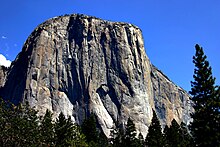

Several big granite faces in the Arctic regions vie for the title of 'highest purely vertical drop on Earth', but reliable measurements are not always available. The possible contenders include (measurements are approximate):
- Mount Thor, Baffin Island, Canada; 1,370 m (4,500 ft) total; top 480 m (1,600 ft) is overhanging. This is commonly regarded as being the largest purely vertical drop on Earth at 1,250 m (4,100 ft).
- The sheer north face of Polar Sun Spire, in the Sam Ford fjord of Baffin Island, has been reported as exceeding Mount Thor's west face in height [6].
- Ketil's west face in Tasermiut, Greenland (also known as God's Thumbnail), has been reported as 1,400 m - 1,450 m high, (although some doubt has been cast on this)[7][8].
Other notable cliffs include:
- Mount Asgard, Baffin Island, Canada; vertical drop of about 1,200 m (4,000 ft).
- Cliffs measured at approximately 1,000 m (3,280 ft) in height can be found along the Sam Ford fjord in Baffin Island, such as Walker Citadel, Kiguti Peak and Great Sail Peak, whilst there are others in Querbitter Fjord, and in Tasermiut, Greenland.
- El Capitan, Yosemite Valley, Sierra Nevada, California, United States; about 900 m (3,000 ft) high
- Painted Wall in Black Canyon of the Gunnison National Park, Colorado, United States; 685 m (2,250 ft)
- Northwest Face of Half Dome, near El Capitan; 1,340 m (4,400 ft) total, vertical portion about 610 m (2,000 ft)
- The west face of Notch Peak in the House Range of southwestern Utah, United States; a carbonate rock pure vertical drop of about 670 m (2,200 ft), with 4,450 feet (1,356 m) from the top of the cliff to valley floor (bottom of the canyon below the notch)
- All faces of Devil's Tower, Wyoming, United States
- Faces of Shiprock, New Mexico, United States
- The North Face of North Twin Peak, Rocky Mountains, Alberta, Canada
- All walls of the Stawamus Chief, Squamish, British Columbia, Canada
- Calvert Cliffs along the Chesapeake Bay in Maryland
- Mt Siyeh Glacier National Park North Face 4200 ft sheer cliff
South America
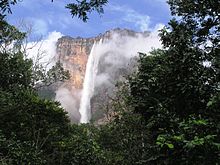
- Autana Tepui, Venezuela stands 1,300 m above the forest floor.
- Auyan Tepui, Venezuela, about 1000 m (location of Angel Falls) (the falls are 979 m, the highest in the world)
- Pared de Gocta, Peru, 771 m
- Fortaleza canyon, Aparados da Serra National Park, Brazil, about 720 m
- Pedra Azul, Pedra Azul State Park, Espirito Santo, Brazil, 540 m
- Pão de Açúcar/Sugar Loaf, Rio de Janeiro, Brazil, 395 m
- All faces of Cerro Torre, Patagonia, Chile-Argentina
- All faces of Cerro Chalten (Fitz Roy), Patagonia, Argentina-Chile
- Faces of the Torres del Paine group, Patagonia, Chile
Africa
Above Sea
- Kogelberg, Western Cape, South Africa, 1289 m above False Bay, Atlantic Ocean
- Table Mountain, Cape Town, Western Cape, South Africa, 1086 m above Atlantic Ocean
- Risco de Faneque, Gran Canaria-Canary Islands, Spain, 1027 m above Atlantic Ocean
- Guguy's Cliffs, Gran Canaria-Canary Islands, Spain, 725 m above Atlantic Ocean
- La Mérica, La Gomera-Canary Islands, Spain, 711 m above Atlantic Ocean
- Andén Verde, Gran Canaria-Canary Islands, Spain, 690 m above Atlantic Ocean
- Karbonkelberg, Western Cape, South Africa, 653 m above Hout Bay, Atlantic Ocean
- La Peña's Cliffs, El Hierro-Canary Islands, Spain, 652 m above Atlantic Ocean
- Los Gigantes, Tenerife-Canary Islands, Spain, 637 m above Atlantic Ocean
- Chapman's Peak, Cape Town, South Africa, 596 m above Atlantic Ocean
- Anaga's Cliffs, Tenerife-Canary Islands, Spain, 592 m above Atlantic Ocean
- Risco de Famara, Lanzarote-Canary Islands, Spain, 580 m above Atlantic Ocean
- Buenavista's Cliffs, Tenerife-Canary Islands, Spain, 546 m above Atlantic Ocean
- High Bluff, Prince Edward Island, South Africa, 490+ m above McNish Bay, Atlantic Ocean
- Cape Hangklip, Western Cape, South Africa, 453.1 m above False Bay, Atlantic Ocean
- Punta Gaviota's Cliff, La Palma-Canary Islands, Spain, 435 m above Atlantic Ocean
- Watertunnel cliffs, Marion Island, Prince Edward Islands, South Africa, ca. 350m above Atlantic Ocean
- The Sentinel, Western Cape, South Africa, 331 m above Hout Bay, Atlantic Ocean
- Cape Point, Western Cape, South Africa, 249 m above Atlantic Ocean.
Above Land
- Drakensberg Amphitheatre, South Africa 1200 m above base, 5 km long. The Tugela Falls, the world's second tallest waterfall, falls 948 m over the edge of the cliff face.
- Mount Meru, Tanzania Caldera Cliffs, 1500 m
- Klein Winterhoek, Western Cape, South Africa, 1220 m above base.
- Tsaranoro, Madagascar, 700 m above base
- Karambony, Madagascar, 380 m above base.
- Innumerable peaks in the Drakensberg mountains of South Africa are spectacular cliff formations. The Drakensberg Range is regarded, together with Ethiopia's Simien Mountains, as one of the two finest erosional mountain ranges on Earth. Because of their near-unique geological formation, the range has an extraordinarily high percentage of cliff faces making up its length, particularly along the highest portion of the range. This portion of the range is virtually uninterrupted cliff faces, ranging from 600m to 1200m in height for almost 250 km. Of all, the "Drakensberg Amphitheatre" (mentioned above) is probably the most impressive individual formation. Other notable cliffs include the Trojan Wall, Cleft Peak, Injisuthi Triplets, Cathedral Peak, Monk's Cowl, Mnweni Butress etc. The cliff faces of the Blyde River Canyon, technically still part of the Drakensberg, may be over 800m, with the main face of the Swadini Buttress approximately 1000m tall.
Oceania
Above Sea
- Mitre Peak, New Zealand, 1683 m above Milford Sound
- The Lion, New Zealand, 1302 m above Milford Sound (drops from approx 1280m to sea level in a very short distance)
- The Elephant, New Zealand, has cliffs falling approx 1180m into Milford Sound, and a 900m drop in less than 300m horizontally
- The Twelve Apostles (Victoria). A series of 17 precipitous peaks (all sharp cliff faces) ranging from ca 700 m to 1067 m above the Bass Strait
- Kalaupapa, Hawaii, 1010 m above Pacific Ocean
- Great Australian Bight
- Ball's Pyramid, a sea stack 562m high and only 200m across at its base
See also
References
- ^ "Natural world: the solar system: highest cliffs". Guinness World Records. Retrieved 2006-08-05.
- ^ "Highest Cliffs". Guinness World Records. Retrieved 2006-05-02.
- ^ "The Encyclopedia of Tourism and Recreation in Marine Environments By Michael Lück". Google Books. Retrieved 2009-08-01.
- ^ "Planet Fear". Retrieved 2009-08-04.
- ^ "TS2 satellites (Expedition Sponsor)". Retrieved 2009-08-04.
- ^ "Polar Sun Spire". SummitPost.Org. Retrieved 2008-07-31.
- ^ "Climbing in Tasermiut". bigwall.dk. Retrieved 2008-09-02.
- ^ "The American Alpine Journal 1986" (PDF). Retrieved 2008-09-02.


